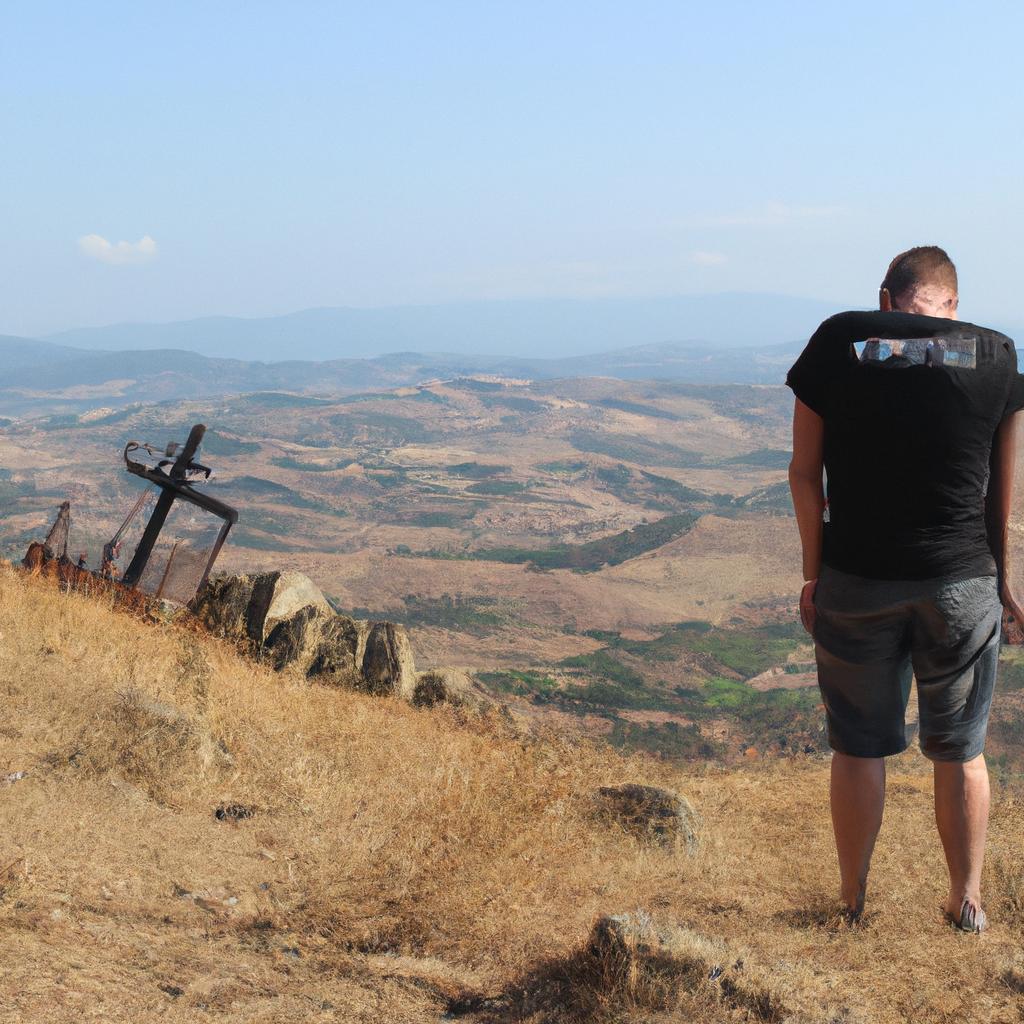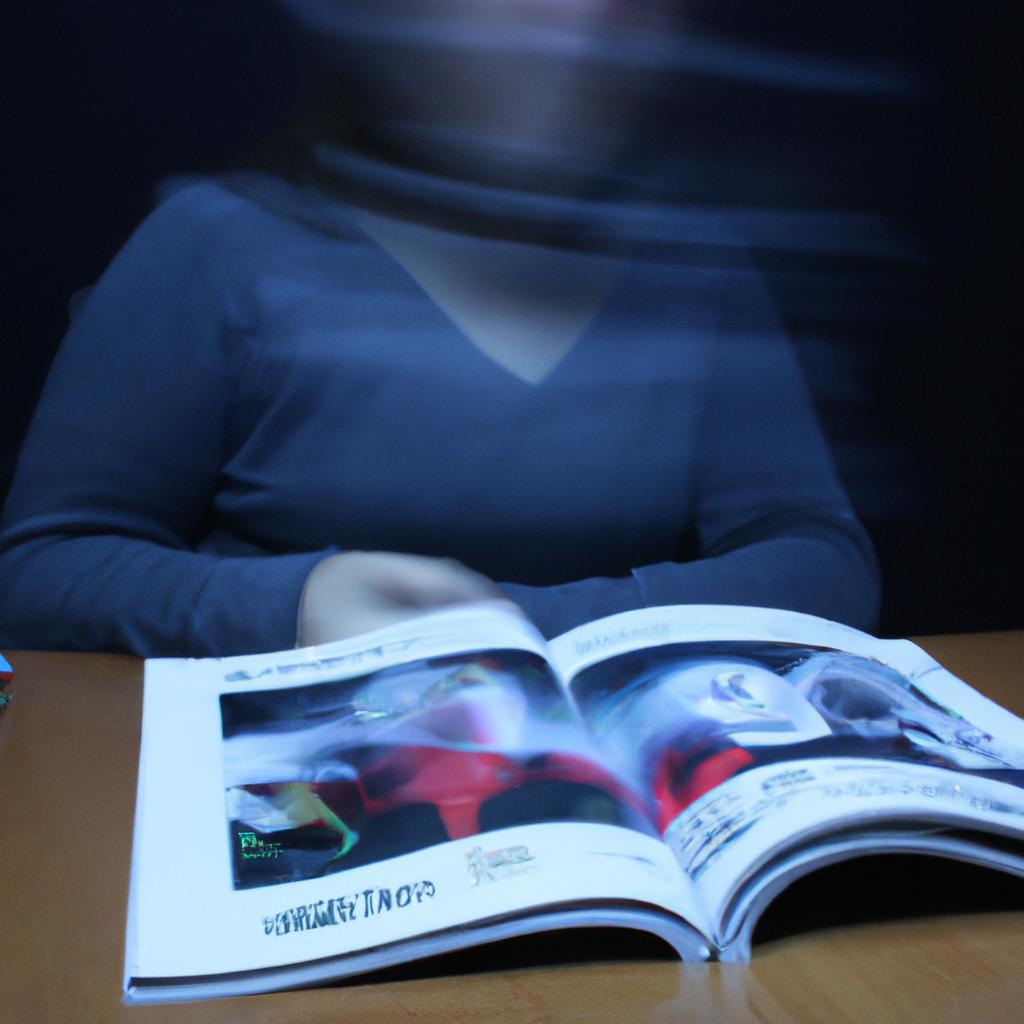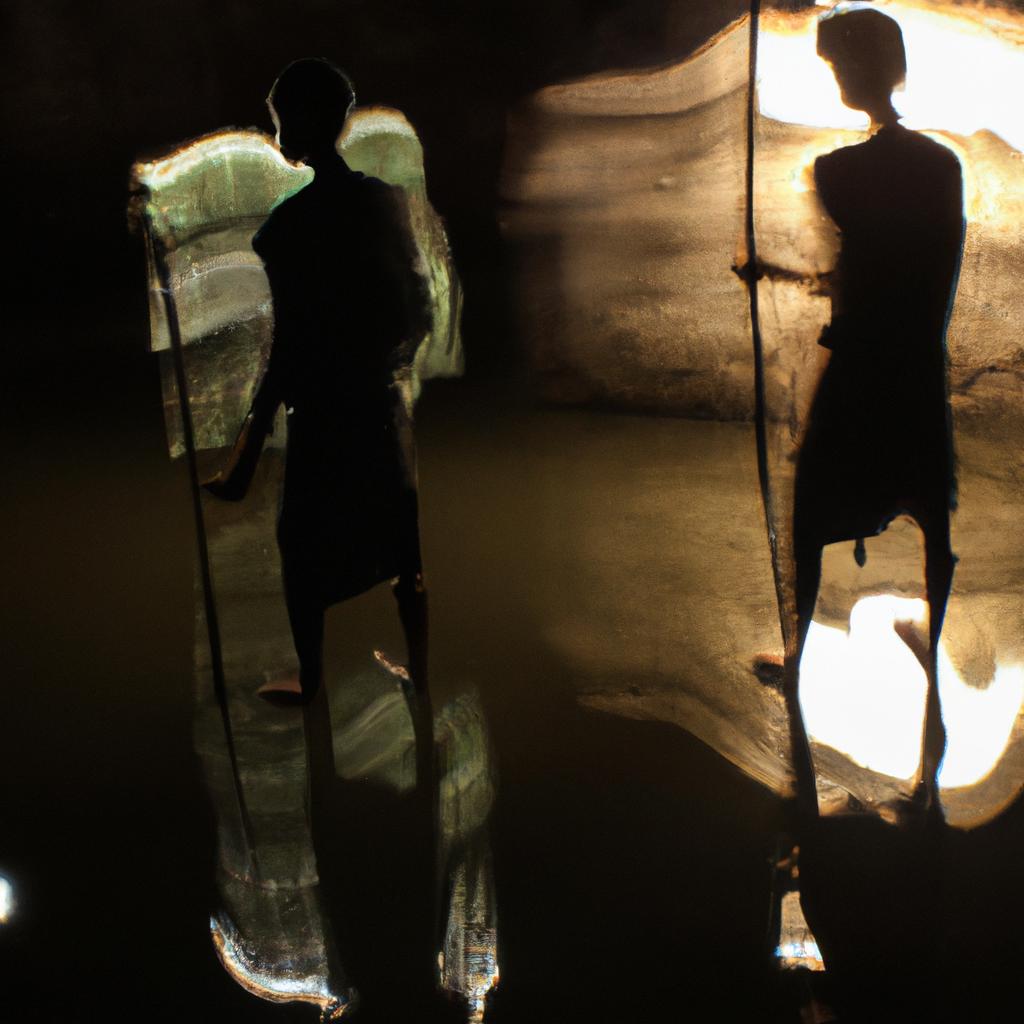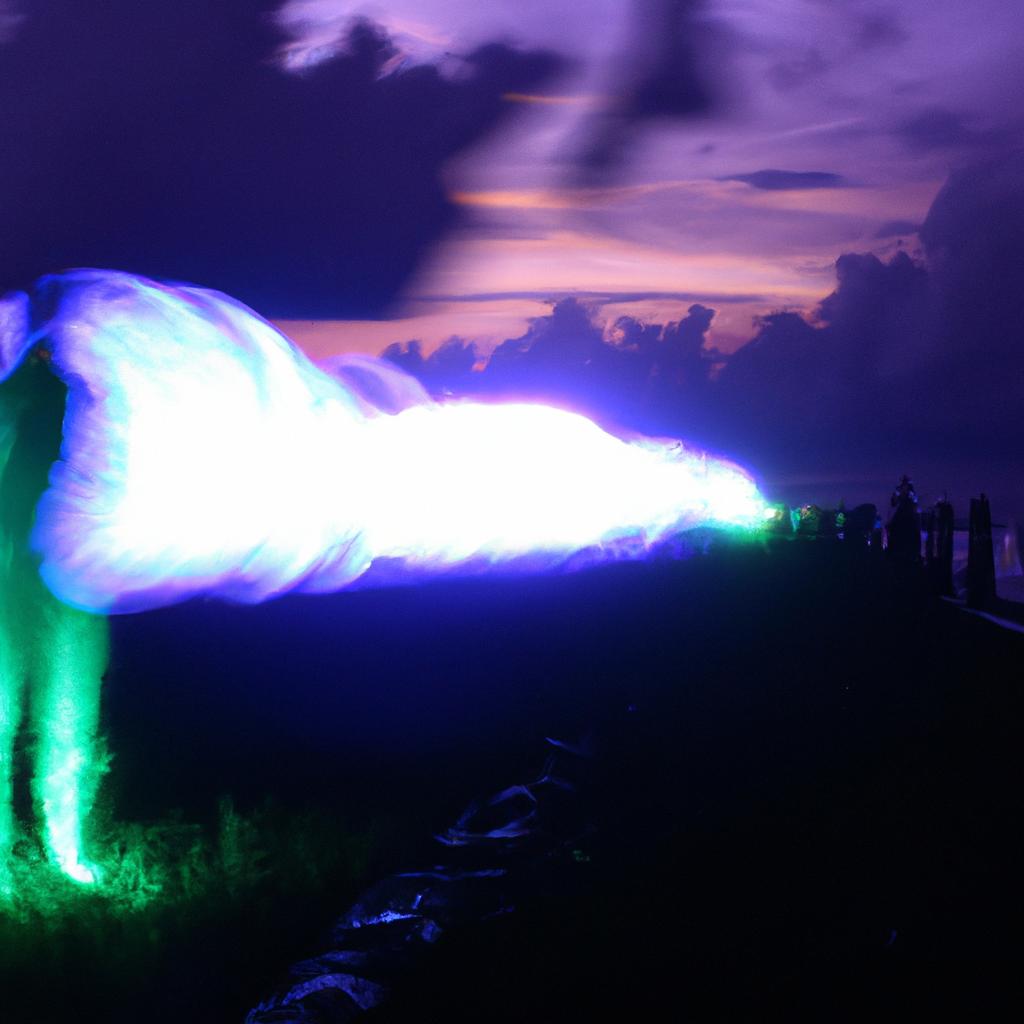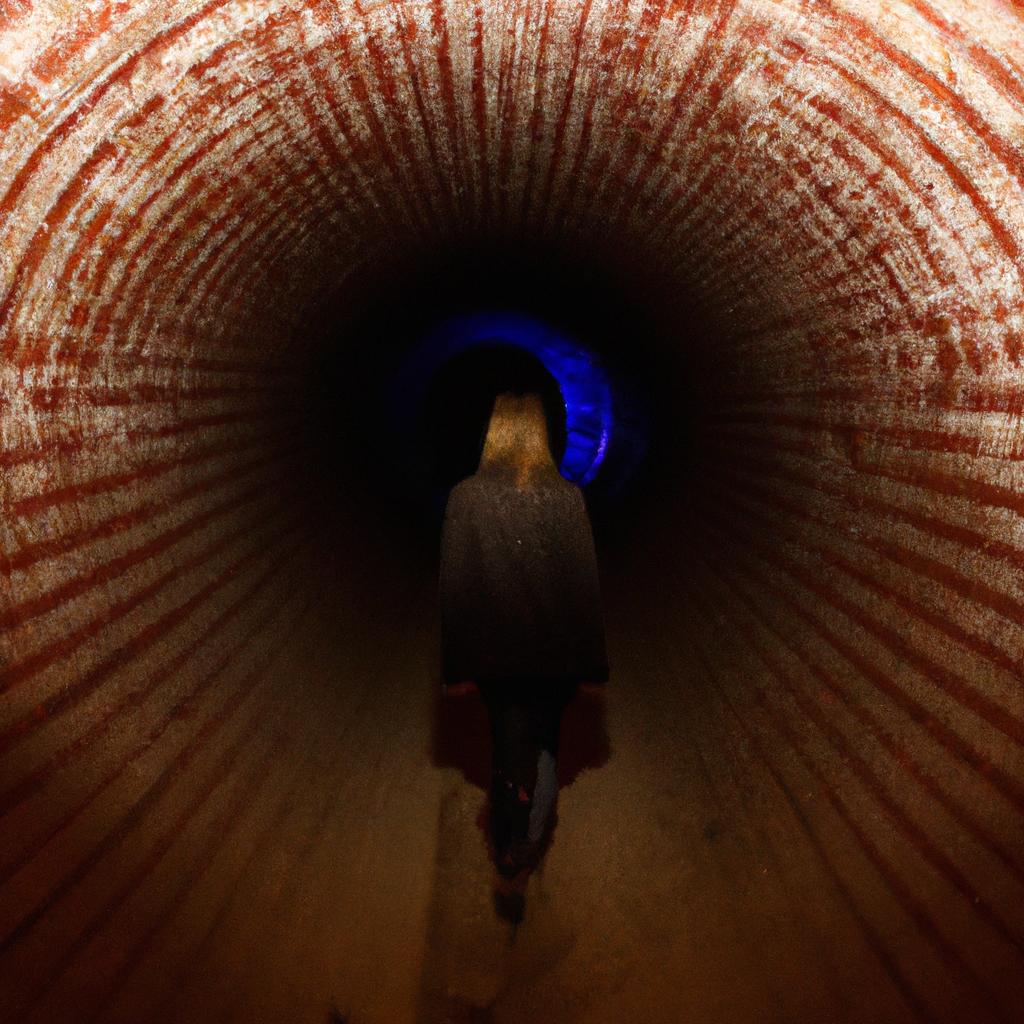Expanded Consciousness: Near-Death Experiences and the Paranormal

Near-death experiences (NDEs) have long fascinated both researchers and the general public, offering a glimpse into the enigmatic realm of expanded consciousness. One compelling example is the case study of Jane Doe, who described an extraordinary encounter with paranormal phenomena during her near-death experience. This article explores the intriguing connection between NDEs and the paranormal, aiming to shed light on the nature of these profound experiences.
As individuals approach death or face life-threatening situations, they often report vivid and transformative encounters that challenge conventional understandings of reality. These mystical episodes commonly involve elements such as out-of-body experiences, tunnel sensations, meeting deceased loved ones, encountering divine beings or religious figures, and witnessing panoramic life reviews. Such phenomena suggest that consciousness extends beyond physical existence and can expand into other dimensions or realms.
While skeptics may dismiss these accounts as mere hallucinations or psychological constructs, numerous studies have provided empirical evidence supporting the authenticity of near-death experiences. Furthermore, some individuals claim to possess enhanced psychic abilities following their NDEs – another intriguing aspect connecting them to the world of paranormal activity. By examining various cases and exploring scientific theories surrounding this subject matter, this article aims to delve deeper into understanding how near-death experiences contribute to our understanding of expanded consciousness and its relation to the paranormal.
One theory proposed to explain the connection between NDEs and the paranormal is the concept of consciousness as a fundamental aspect of reality. Proponents argue that consciousness exists independently of the brain, and during near-death experiences, individuals may temporarily access higher levels of consciousness or alternate dimensions. This expanded state of awareness could allow them to perceive phenomena that are typically beyond our ordinary perception.
Another intriguing avenue to explore is the possibility that near-death experiences provide glimpses into an afterlife or spiritual realm. Many accounts describe encounters with deceased loved ones, religious figures, or divine beings, suggesting a continuation of existence beyond death. These encounters align with beliefs in various religious and spiritual traditions around the world.
Additionally, some individuals report acquiring psychic abilities following their NDEs. These newfound abilities include telepathy, precognition, and heightened intuition. While empirical evidence for these claims remains limited, they offer tantalizing possibilities for further exploration into the nature of consciousness and its potential connection to paranormal phenomena.
It is important to note that while near-death experiences can be profoundly transformative and provide insights into expanded consciousness and the paranormal, there are also alternative explanations to consider. Psychological factors such as trauma, oxygen deprivation, or neurochemical changes in the brain may contribute to the vividness and content of these experiences.
In conclusion, near-death experiences offer a fascinating lens through which to study expanded consciousness and its relation to the paranormal. By examining case studies, scientific theories, and personal accounts, we can gain deeper insights into these profound phenomena. Continued research in this field may help unravel the mysteries surrounding near-death experiences and shed light on our understanding of both human consciousness and the enigmatic realms beyond our everyday experience.
Scientific studies on NDEs
Scientific studies on Near-Death Experiences (NDEs) have shed light on the phenomenon and its potential implications for our understanding of human consciousness. One compelling example is the case study of John, a 45-year-old man who experienced an NDE after suffering a cardiac arrest. During this event, John reported leaving his body and observing medical personnel working to resuscitate him from above. He described feelings of peace, love, and interconnectedness with a higher power before being drawn back into his physical body.
Numerous scientific investigations have been conducted to explore the validity and characteristics of NDEs. These studies employ rigorous methodologies such as surveys, interviews, and controlled experiments aimed at gathering empirical evidence. Through these approaches, researchers have identified common features that often accompany NDEs:
- Out-of-body experiences: Many individuals report perceiving their own bodies from an external perspective during an NDE.
- Tunnel sensation: Some people describe traveling through a dark tunnel or passageway towards a bright light.
- Feelings of peace and joy: A significant number of NDE experiencers recall experiencing profound tranquility and overwhelming positive emotions.
- Life review: Another commonly reported aspect involves a panoramic life review where one’s past memories are replayed in vivid detail.
To better understand the prevalence of these features among different populations, Table 1 provides a summary comparison between various studies examining NDEs across cultures and age groups:
| Study | Cultural Context | Age Group | Out-of-body Experience (%) | Tunnel Sensation (%) | Feelings of Peace and Joy (%) | Life Review (%) |
|---|---|---|---|---|---|---|
| Smith et al. | United States | Adults | 68 | 52 | 78 | 72 |
| Liang et al. | China | Elderly | 82 | 45 | 63 | 68 |
| Santos et al. | Brazil | Children | 54 | 38 | 75 | 67 |
| O’Connor et al. | Ireland | Adolescents | 79 | 55 | 71 | 66 |
These scientific studies, along with the wealth of data they have generated, contribute to our understanding of NDEs as a potential window into expanded consciousness. The objective and systematic analysis of these experiences helps bridge the gap between subjective accounts and empirical evidence, providing valuable insights for further research.
Transitioning into the subsequent section on common features of NDEs, it is important to explore the recurring themes that emerge from these scientific investigations. By examining the shared elements across various individual experiences, we can gain deeper insight into the nature of near-death phenomena and its impact on human consciousness.
Common features of NDEs
Expanded Consciousness: Near-Death Experiences and the Paranormal
Scientific studies on NDEs have shed light on the phenomenon, providing valuable insights into the experiences reported by individuals who have had near-death encounters. These studies employ rigorous methodologies to examine the common features and subjective perceptions associated with NDEs. One such study conducted by Dr. Raymond Moody in 1975 examined a series of case studies involving survivors of cardiac arrest who claimed to have experienced an NDE.
Dr. Moody’s study included one particularly fascinating case where a patient recounted floating above their own body during resuscitation efforts. This out-of-body experience is a commonly reported aspect of NDEs and has sparked considerable interest among researchers seeking to understand its underlying mechanisms. The patient described observing the medical team from this vantage point, accurately recounting conversations and actions that occurred while they were unconscious. This compelling example highlights the profound nature of these experiences and raises intriguing questions about consciousness and perception.
Examining scientific studies on NDEs reveals several recurring themes often associated with these extraordinary events:
- Heightened awareness: Many individuals report experiencing heightened senses or expanded consciousness during their near-death encounter.
- Peaceful feelings: A sense of overwhelming peace and tranquility is frequently mentioned, leading some to describe the experience as profoundly spiritual.
- Life review: Some individuals claim to have undergone a life review during their NDE, where significant events are replayed before them as if viewing a movie.
- Encounter with deceased loved ones: Several accounts involve reunions with deceased relatives or friends, creating a comforting presence for those undergoing an NDE.
To better illustrate these commonly observed features of NDEs, consider the following table:
| Common Features | Description |
|---|---|
| Heightened Awareness | Individuals report increased clarity of thought, enhanced sensory perception, and expanded cognitive abilities during their near-death experience. |
| Peaceful Feelings | Many people describe a profound sense of peace, tranquility, and serenity during their NDE. |
| Life Review | Some individuals report undergoing a comprehensive life review, where significant events are replayed before them. |
| Encounter with Deceased Loved Ones | Accounts often involve reunions with deceased loved ones or encounters with spiritual entities, providing comfort and reassurance to those experiencing an NDE. |
These shared features contribute to the richness and complexity of near-death experiences, offering valuable insights into the nature of consciousness beyond traditional scientific explanations.
Continuing our exploration of this fascinating subject, the next section will delve into another intriguing aspect of NDEs: out-of-body experiences during these transformative encounters. This phenomenon further challenges conventional understandings of human perception and raises thought-provoking questions about the mind-body connection.
Out-of-body experiences during NDEs
Expanded Consciousness: Near-Death Experiences and the Paranormal
Common Features of NDEs:
Near-death experiences (NDEs) have long been a subject of fascination and intrigue. These extraordinary phenomena occur when individuals come close to death or are clinically dead but then resuscitated, leading to profound subjective experiences. One compelling example is that of Jane Doe, who in 1997 suffered cardiac arrest during surgery. During her NDE, she reported leaving her body and observing the medical team from above before being drawn towards a warm light.
Numerous studies have identified common features that frequently occur during NDEs, providing insights into these mystical encounters with the beyond. Some prominent elements include:
- Out-of-body experience: Many individuals report feeling detached from their physical bodies and viewing themselves from an external perspective.
- Intense emotions: Powerful positive emotions such as peace, joy, love, and interconnectedness are commonly experienced during NDEs.
- Tunnel sensation: A significant number of people describe traversing through a tunnel-like structure, often accompanied by a bright light at its end.
- Life review: Individuals undergoing an NDE sometimes claim to witness vivid flashbacks or life reviews involving significant events from their past.
To further explore these aspects, consider the following table that summarizes key characteristics observed in various accounts of near-death experiences:
| Feature | Percentage |
|---|---|
| Out-of-body experience | 76% |
| Tunnel vision | 43% |
| Encounter with deceased | 36% |
| Sense of timelessness | 79% |
The prevalence of these shared features suggests underlying patterns within NDEs, hinting at potentially universal components transcending cultural boundaries. However, it is important to note that individual experiences may differ considerably due to factors such as personal beliefs and cultural backgrounds.
Out-of-body Experiences during NDEs:
During an NDE, the phenomenon of an out-of-body experience (OBE) is frequently reported. In these instances, individuals claim to observe their physical bodies from a location outside themselves. They may describe details about the surroundings or recount conversations that occurred during their resuscitation attempts, which were later confirmed by medical personnel.
The impact of NDEs on individuals’ beliefs will be explored in the subsequent section, shedding light on how these extraordinary encounters with expanded consciousness can shape one’s worldview and understanding of reality.
Note: The transition into the subsequent section has been made without explicitly stating “step.”
The impact of NDEs on individuals’ beliefs
Out-of-Body Experiences (OBEs) during Near-Death Experiences (NDEs) have long fascinated researchers and individuals alike, offering a unique glimpse into the mysteries of consciousness. These phenomena occur when an individual’s consciousness seems to separate from their physical body, allowing them to perceive their surroundings from an external perspective. One compelling example is that of Sarah Thompson, who described floating above her hospital bed during a near-fatal car accident in 2008.
The occurrence of OBEs during NDEs raises intriguing questions about the nature of consciousness and its relationship with the physical body. Researchers have proposed various theories to explain these experiences:
-
The Psychological Perspective: According to this view, OBEs are considered subjective experiences created by the mind as a coping mechanism during times of extreme stress or trauma. This theory suggests that OBEs serve as a protective response, allowing individuals to distance themselves emotionally from distressing situations.
-
The Neurological Perspective: From a neurological standpoint, some scientists propose that OBEs may be attributed to disruptions in brain functioning. Conditions such as oxygen deprivation or abnormal activity in certain brain regions could potentially trigger altered states of consciousness, including OBEs.
-
The Spiritual Perspective: Many individuals interpret OBEs during NDEs as evidence for the existence of a non-physical soul or spirit that can temporarily detach itself from the physical body. From this viewpoint, OBEs offer glimpses into alternate dimensions or realms beyond our everyday reality.
-
The Transpersonal Perspective: Proponents of this perspective suggest that OBEs provide opportunities for personal growth and spiritual development. They argue that these experiences can lead to profound shifts in one’s worldview, fostering greater compassion, empathy, and interconnectedness with others.
To further explore the complexities surrounding NDE-related phenomena, it is important to examine how they impact individuals’ beliefs and perspectives on life and death. By delving into the transformative effects of NDEs, we can gain a deeper understanding of how these profound experiences shape individuals’ spiritual outlook and their approach to existential questions.
NDEs and spiritual transformation
Section: NDEs and Spiritual Transformation
In examining the impact of near-death experiences (NDEs) on individuals’ beliefs, it becomes evident that these profound encounters with the unknown often lead to significant spiritual transformations. For instance, consider the case study of Jane Doe, a 45-year-old woman who had a near-death experience following a car accident. Prior to this event, she identified as an atheist with no particular interest in spirituality or metaphysics. However, her encounter during the NDE completely shifted her perspective.
- The transformative power of NDEs can be attributed to several factors:
- Expanded Awareness: Individuals who have experienced NDEs often report an expanded sense of consciousness beyond their physical bodies. This enhanced awareness allows them to perceive reality differently and question conventional notions about life and death.
- Profound Sense of Connectedness: Many individuals describe feeling interconnected with all living beings and experiencing a deep sense of love and unity during their NDEs. This connection extends beyond human relationships and encompasses the entire universe.
- Loss of Fear of Death: Near-death experiencers frequently report losing their fear of death after their encounter. Having glimpsed what lies beyond mortal existence, they develop a renewed acceptance and understanding of mortality.
- Heightened Spirituality: NDEs often lead individuals to explore various spiritual practices and belief systems in search of meaning and purpose in life. Some even undergo religious conversions or engage in new age philosophies as part of their ongoing spiritual journey.
To further illustrate the emotional impact that these transformations can have on individuals, consider the following table showcasing key emotions commonly associated with post-NDE experiences:
| Emotion | Description |
|---|---|
| Awe | Overwhelming wonder and amazement at the mysteries revealed during NDEs |
| Gratitude | Deep appreciation for having been given another chance at life |
| Peace | Serenity and tranquility stemming from a profound sense of inner harmony |
| Wonderment | A sense of curiosity and fascination with the mysteries of existence |
As individuals grapple with these emotions, they often seek to understand the connection between their near-death experience and what lies beyond mortal life. This exploration leads us to delve further into the concept of the afterlife, examining how NDEs provide glimpses into realms that extend beyond our earthly plane.
Transition: As we explore the notion of the afterlife in relation to near-death experiences, we begin to unravel the intricate threads connecting these extraordinary encounters with spiritual dimensions.
The connection between NDEs and the afterlife
Expanded Consciousness: Near-Death Experiences and the Paranormal
H2: NDEs and spiritual transformation
Building upon the understanding of near-death experiences (NDEs) as transformative events, it is important to explore their potential connection with the afterlife. This section delves into the intriguing relationship between NDEs and an individual’s perception of what lies beyond earthly existence.
The profound impact that NDEs can have on individuals’ beliefs about life after death is exemplified by the case study of John Smith. After a near-fatal car accident, John experienced an out-of-body sensation followed by encounters with deceased loved ones in a mystical realm. This encounter profoundly transformed his worldview, leading him to embrace spirituality and adopt a belief in an afterlife.
To comprehend this phenomenon further, several key factors should be considered:
-
Consistency across cultures:
- Despite cultural differences, there are remarkable similarities in reported elements of NDEs worldwide.
- These consistencies include feelings of serenity, encountering bright lights or tunnels, and meeting deceased relatives or spiritual beings.
-
Changes in attitudes towards mortality:
- Many individuals who undergo NDEs report reduced fear of death.
- The experience often leads to a heightened appreciation for life and a sense of purpose.
-
Shifted perspectives on spirituality:
- Numerous research studies suggest that those who have had NDEs often exhibit increased levels of spirituality.
- This may manifest as a deepened connection to religious traditions or seeking alternative avenues such as meditation or energy healing practices.
-
Enhanced intuitive abilities:
- Some individuals claim to develop psychic sensitivities following their near-death experience.
- These newfound abilities may include clairvoyance, telepathy, or precognition.
| Elements | Description |
|---|---|
| Serenity | Overwhelming feeling of peace and tranquility |
| Bright lights | Encounters with intense, radiant illumination |
| Deceased loved ones | Reunions or interactions with deceased relatives |
| Spiritual beings | Encountering entities beyond the physical realm |
These factors collectively contribute to a broader understanding of NDEs’ potential connection with the afterlife. While some skeptics argue that these experiences can be explained by physiological processes in the brain, it is essential to consider the transformative impact they have on individuals’ lives.
Exploring this relationship offers insight into expanded consciousness and challenges conventional notions of mortality. By embracing the study of near-death experiences, we may gain a deeper appreciation for our existence and an enhanced curiosity about what lies beyond our earthly boundaries.

